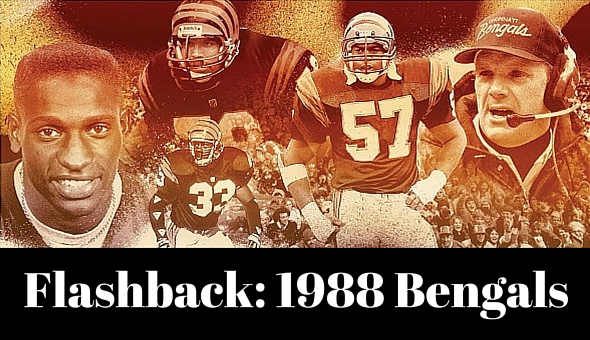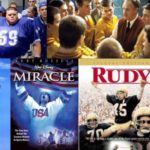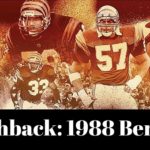It’s hard to believe that it has been over 30 years since San Francisco knocked off Cincinnati to win Super Bowl XXIII. Lost in one of the greatest comebacks in Super Bowl history was just how good the 1988 Bengals were as a football team.
After finishing just 4-11 in 1987, the expectations for the ‘88 team were not that high. However, the team made it clear out of the gate that this year was going to be different. They raced out to a 6-0 start before finishing 12-4 and completing one of the greatest single-year turnarounds in NFL history.
Here’s a look back at Super Bowl XXIII (from WCPO):
LINK: 1988 CINCINNATI BENGALS (Pro-Football-Reference.com)
The strength of the team was on offense where quarterback Boomer Esiason mastered the play-action pass while running Sam Wyche’s hurry-up offense.
The NFL had not seen anything like the “No Huddle Offense” before. The Bengals would race to the line, preventing opposing teams to adjust or make personnel changes. It frequently resulted in exploitable mismatches for the Bengals, the opposing team having to call a timeout or often them being flagged for a penalty for having too many men on the field.
Teams had no answer and the Bengals’ offense took full advantage. The unit would finish the season ranked the best in the league in total points and total yards.
The Seattle Seahawks, faced with stopping the Bengals in the first round of the AFC playoffs that season, had defensive lineman Joe Nash continue to go down with an injury in an attempt to slow down the game. The league would later change a rule, forcing a team to use a timeout or be penalized when a player gets injured with less than two minutes on the clock.
The Buffalo Bills, the team the Bengals beat 21-10 in the AFC Championship game that season, decided if they couldn’t beat the Bengals’ No-Huddle attack they might as well join them and run it themselves. The team would parlay it into four straight AFC Championships in the years to follow.
“Marv Levy’s headline was that the ‘No Huddle is No Fair.’ This was right after the ’88 season and the next year they’re running it and actually the next year is when they ‘invented it,'” former Bengals’ head coach Sam Wyche said during an interview for the documentary America’s Game: The Missing Rings.
Esiason would flourish in the system and finished the year throwing for 3,572 yards and 28 touchdowns on his way to winning the NFL’s Most Valuable Player award.
Protection was a big part of the left-handed slinger’s success. Hall of Famer Anthony Munoz and fellow Pro Bowler Max Montoya anchored one of the league’s most dominating offensive lines.
The team also had a stable of capable receivers. Wideouts Eddie Brown (Pro Bowl – 53 rec, 1273 ReYd, 9 ReTD) and Tim McGee (36 rec, 686 ReYd, 6 ReTD) formed one of the best duos in the league. Tight end Rodney Holman (39 rec, 527 ReYd, 3 TD) was one of a team-record nine Pro Bowl selections that season.
As good as the passing game was for the Bengals, the running attack was equally impressive. Rookie Ickey Woods and James Brooks combined for a franchise-record seven 100-yard rushing games.
The team grabbed Woods out of UNLV with their second-round pick in that April’s rookie draft. By the time Fall arrived, Woods captivated the nation with his touchdown celebration dance, “The Ickey Shuffle”. The former Runnin’ Rebel did plenty of dancing that season, finishing with 15 touchdowns and 1066 yards on 203 carries.
“I can’t, to this day, go to a speaking engagement where someone doesn’t ask me, ‘Would you do the Ickey Shuffle?'” Wyche said.
Woods was the power back of the offense while Brooks served as the change-of-pace runner. The veteran was as impressive both as a runner and a receiver, often making defenders miss with his elusiveness. He churned out 981 yards and eight touchdowns on 182 carries while adding another 287 yards and six scores on just 29 catches.
Fullback Stanley Wilson, long remembered for his being held out of the Super Bowl after missing team meetings while on a drug rampage on the eve of the biggest game of his life, made a huge impact as the lead blocker throughout the year.
One of my favorite parts of the 1988 team was the rap song they produced just prior to Super Bowl XXIII:
The defense was often lost in the spotlight of the team’s prolific offense, but the unit had its hand in the team’s success.
Defensive guru Dick LeBeau called the shots for Cincinnati’s defense during the 1988 season. The unit would only finish 17th in the league (5,556 total yards allowed, 329 points allowed) in total defense, but there were several individuals that stood out.
Defensive lineman Tim Krumrie (team-high 152 tackles) was the heart-and-soul of the defense. He often drew double-team coverage, creating opportunities for teammates Jim Skow (9.5 sacks), Jason Buck (6 sacks) and David Grant (5 sacks). Krumrie was unable to make his trip to the Pro Bowl after suffering a gruesome leg injury in the loose Joe Robbie Stadium turf during the Super Bowl loss to the 49ers.
“Tim was the spirit of the defense. He was the one that everyone looked at and said, ‘if he can go that hard, that many snaps, then we can do it.’ He was a big part of everything coming together,” Wyche stated.
The secondary also featured two Pro-Bowlers, cornerback Eric Thomas and the hard-hitting safety David Fulcher. The duo combined for 12 interceptions.
Veteran Reggie Williams led the underrated corps of linebackers and was named Sports Illustrated’s Sportsman of the Year shortly after the season.
Special teams were also a strength of the team. Punter Lee Johnson averaged 42.4 yards per kick, but was only called upon to punt 14 times. Kicker Jim Breech connected on 11 of 16 field goals, missing only one kick all year inside the 40. The returning game was solid, highlighted by Stanford Jennings. He scored the team’s only touchdown in Super Bowl XXIII on a 93-yard kickoff return.
In the end, the 1988 Bengals came up one game short of going down as one of the greatest teams ever. Instead the 49ers would go on to win their fourth title of the decade (second over the Bengals) and become the team of the 1980’s. The Bengals have yet to get this close to a title again.
Shortly after the season, team owner and football icon Paul Brown passed away. Injuries and free agency would take its toll on the team. They would finish 8-8 in the next season before rebounding to 9-7 in 1990 and squeaking into the playoffs. Following that they would go 15 years before their next winning season and division title, making fans appreciate the memorable 1988 team that much more.
Talk #Bengals with me on Twitter @DanClasgens
*Image from Cincinnati Magazine










